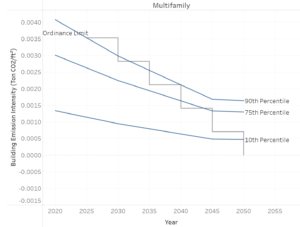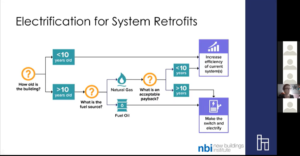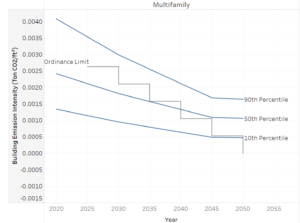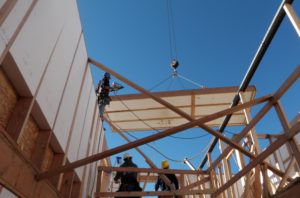Building Performance Standards
Building performance standards (BPS) set targets for existing building energy performance and are one of the best tools we have for achieving deep energy savings and emissions reductions in existing buildings. They can be written to optimize the energy use in older buildings, as well as protect and conserve water, enhance indoor air quality, reduce waste and air pollution, and create jobs.
Today, five cities (Boston, Chula Vista, District of Columbia, New York City and St. Louis) and two states (Colorado and Washington) have enacted BPS. Yet a growing number of cities and states are considering BPS policies as a way to meet climate, equality, public health and financial goals.
Soon, $1.8 billion from the new Bipartisan Infrastructure Legislation will become available to local governments that want to pursue BPS policy. The Biden Administration has announced that 33 states and cities that have committed to pass BPS legislation or policies by Earth Day 2024. These states and cities represent roughly 20% of U.S. buildings.

Why focus on existing buildings?
- There are 5.9 million existing commercial buildings in the U.S. comprising 97 billion square feet. [1]
- Replacement rate of buildings, demolition, and new construction, is less than 2% per year, leaving a vast amount of outdated technologies in current building stock.[2]
- We spent over $1 trillion on construction in 2015[3] with only about $50 billion focused on energy retrofits of commercial buildings.[4]
- More than $279 billion could be invested in existing U.S. building retrofits, according to Deutsche Bank, yielding more than $1 trillion of energy savings over 10 years.[5]
- Savings potential is equivalent to 30% of the total annual electricity spending in the U.S. and would create thousands of jobs.[6]
Setting the right targets to maximize energy and carbon reduction
The power of BPS comes from setting the right targets that align with climate goals and drive actions at the right pace to ensure investments are focused on achieving long term compliance and emissions reductions. NBI assists jurisdictions in setting these targets. By using benchmarking data and potential targets, combined with data from the projections of cleaning grids, this type of analysis can aid jurisdictions in understanding the impact of their policies from the number of buildings likely to be required to comply each cycle to the total GHG emissions reductions expected over the life of the policy.
Based on NBI’s analysis for a city considering adoption of a BPS, a dashboard was created to allow jurisdiction stakeholders to visualize ordinance stringency and impact across building types and their current levels of performance.
To explore the impact of a carbon ordinance in this tool, users can select options for the ordinance starting point (either 75th percentile or 90th) along with the type of building and the current reported performance level(s). Each step of the gray line is the end of a compliance period, where the ordinance increases stringency by decreasing the allowable carbon emissions intensity. These lines assume no improvement to the building efficiency and are based on current reported benchmarking data. The graphs will update plot information to help inform internal and external stakeholder discussions within a jurisdiction.
| 75th Percentile | 90th Percentile |
Not only valuable from a technical perspective, this method to target setting can inform stakeholder engagement and aid jurisdictions in understanding potentially needed incentives by taking a closer look at the specific buildings that are projected to be out of compliance in each cycle. Knowing if a particular set of affordable housing properties or a large number of buildings in a single community will be impacted during the same implementation phase during the policy design can help focus resources leading to greater compliance and less uncertainty from stakeholders.
Getting started on Building Performance Standards
States and cities that are seeking to enact BPS policies have resources to draw from here. NBI recently published a three-part series of blogs explaining the aspects of BPS policy.
Delivering Climate Solutions from Existing Buildings: No Time to Waste
 This blog lays out the case for investing in existing building efficiency with BPS as a policy strategy. By requiring buildings to be more energy efficient, cities could cut about 30% of all urban emissions by 2050, according to a September 2019 report by Coalition for Urban Transitions. In addition to the operational energy- and carbon-saving benefits from efficiency retrofits in existing buildings, it’s worth noting the high levels of embodied carbon that could be saved (mainly in steel, concrete, and windows) by reusing and improving existing buildings rather than demolishing and rebuilding.
This blog lays out the case for investing in existing building efficiency with BPS as a policy strategy. By requiring buildings to be more energy efficient, cities could cut about 30% of all urban emissions by 2050, according to a September 2019 report by Coalition for Urban Transitions. In addition to the operational energy- and carbon-saving benefits from efficiency retrofits in existing buildings, it’s worth noting the high levels of embodied carbon that could be saved (mainly in steel, concrete, and windows) by reusing and improving existing buildings rather than demolishing and rebuilding.
 Implementing Building Performance Standards: Consistency is Key
Implementing Building Performance Standards: Consistency is Key
As a forward-looking policy for existing buildings, BPS commits a city or state to a long-term, high-performance standard (i.e. energy or carbon intensity), with interim targets that ratchet up over time. This blog explains the aspects of BPS policy including metrics and goals, how to determine the parameters of the standard and which buildings should be covered, as well as compliance considerations.
Read Part Two
Reduce Carbon in Existing Buildings and Put America Back to Work
This final blog focuses on the other benefits jurisdictions can derive from energy efficiency investments in existing buildings, including measures that are known to also improve the health and safety of residents and create better paying jobs that fuel local economies. Recent research shows that converting equipment and appliances from gas combustion to electricity delivers healthier air both inside and outside buildings by reducing the release of toxic particulates and gases. Building electrification is one policy objective that can be incorporated into BPS to address the health risks associated with combustion from gas stoves and appliances.
Read Part ThreeWhite Papers & Research
NBI has published two white papers on Building Performance Standards with partners at ACEEE and IMT that dig into why this is a viable policy for existing buildings and how jurisdictions can develop and apply BPS.
The Technical Basis of Building Performance Standards
As leading cities and states seek to meet their aggressive climate, energy, and decarbonization goals, they are turning increasingly to mandatory policies that require improved energy and emissions performance across their existing building stock. The most comprehensive of these policies is the building performance standard, in which performance thresholds are set that building owners must meet at a specified time or when a triggering event occurs. BPS can address a range of emissions, energy, and grid-related goals. This paper examines technical approaches used to set the key metrics for both buildings and fuels in performance standard legislation. Some of these metrics include emissions levels per square foot, energy use per square foot, and pounds of greenhouse gases per kilowatt-hour consumed.
Read the White Paper
Raising the Standard: Building Performance and the Reshaping of Urban Energy Regulation
BPS can address a range of emissions, energy, and grid-related goals. While energy efficiency has been the go-to metric for building energy policies for a generation, the rapid greening of the grid, the penetration of renewable energy, the importance of load management, and the larger goal of a decarbonized energy system is changing that focus. The authors are actively working with almost a dozen cities crafting BPS ordinances and providing analyses that inform standard setting. This paper provides an overview of BPS policies and explore key considerations for policymakers as they develop and implement impactful and practical BPS policies that can facilitate and balance electrification, demand reduction, and grid interactivity strategies.
Read the White PaperOther NBI Building Performance Standards and existing building efficiency resources
Podcast: How to Prepare for Building Performance Standards: An Interview with New Buildings Institute
Building Performance Standards will soon change how we design and operate buildings. To help building operators and designers get ahead of the curve, SlipStream turned to colleagues at New Buildings Institute to explain BPS and what building owners can do to prepare for the coming policies.
Listen to the Podcast
 On Demand Webinar: Where DC’s Building Codes Meet BEPS
On Demand Webinar: Where DC’s Building Codes Meet BEPS
How might a building built to DC’s Energy Conservation Code fare with respect to the Building Energy Performance Standard (BEPS)? This on demand webinar, from DC’s Building Innovation Hub, examines the differences and similarities as well as the perceived challenges and opportunities between the BEPS and Code. The session outlines permitting, design, construction, and commissioning considerations, and highlight tools and resources common to both DC Code and the BEPS. This detailed, technical session is designed for engineers and building design practitioners.
Watch the Webinar
Public Buildings Portfolio Management
The Public Buildings Portfolio Management framework enables cities to lead by example by focusing on the city’s own building portfolio. This turnkey approach for managing and improving the energy use of the city’s buildings provides defined steps to help cities convert goals and policies into true performance results. The approach leverages energy benchmarking data and easy-to-use open-source software to organize data, visualize energy usage trends, and uncover high priority opportunities for energy performance improvement across the municipal portfolio.
Learn More
FirstView
FirstView is a software tool that enables building owners and designers to extract more targeted and useful energy performance information from basic data inputs. The software takes in basic building data and one year’s energy usage and uses multivariable regression analysis to come up with a physical simulation model of the building. The outputs are simple but powerful: we can disaggregate end uses (heating, cooling, electric baseload, and gas/steam baseload), provide diagnostic recommendations for those end-use categories, and compare a building’s energy performance to benchmark values or to previous years’ performance. This means we can go beyond basic EUI comparisons to help building owners and managers prioritize energy audit efforts and focus on the best retrofit opportunities.
Learn MoreOther resources
USDN Building Performance Standards
USDN Building Performance Standards for Local Governments Webinar featuring Erin Beddingfield
USDN Building Performance Standards for Industry Professionals Webinar featuring Kim Cheslak
U.S. EPA Understanding and Choosing Metrics for BPS and Zero-Carbon Recognition
IMT Building Performance Standards webpage
Mandatory Building Performance Standards: A Key Policy for Achieving Climate Goals
Getting to Zero Codes & Policy Resource Hub
ASHRAE Decarbonization Task Force Building Performance Standards Resources and Publications
ASHRAE Decarbonization Task Force Using Building Performance Standards to Address Carbon Emissions
ASHRAE Decarbonization Task Force Building Performance Standards Needs Assessment
For questions, please reach out to NBI Director of Codes, Julia Hustwit.


